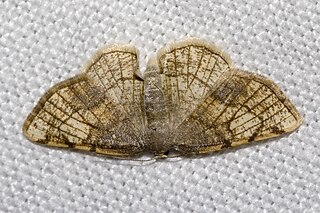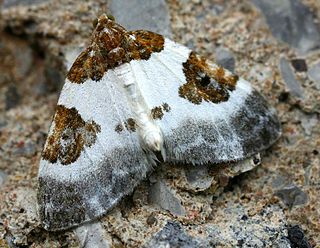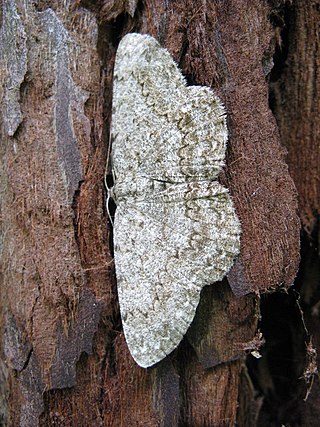
The geometer moths are moths belonging to the family Geometridae of the insect order Lepidoptera, the moths and butterflies. Their scientific name derives from the Ancient Greek geo γεω, and metron μέτρον "measure" in reference to the way their larvae, or inchworms, appear to measure the earth as they move along in a looping fashion. Geometridae is a very large family, containing around 23,000 described species; over 1400 species from six subfamilies are indigenous to North America alone. A well-known member is the peppered moth, Biston betularia, which has been the subject of numerous studies in population genetics. Several other geometer moths are notorious pests.

Ennominae is the largest subfamily of the geometer moth family (Geometridae), with some 9,700 described species in 1,100 genera. Most species are fairly small, though some grow to be considerably large. This subfamily has a global distribution. It includes some species that are notorious defoliating pests. The subfamily was first described by Philogène Auguste Joseph Duponchel in 1845.

The Bistonini are a tribe of geometer moths in subfamily Ennominae. As numerous ennomine genera have not yet been assigned to a tribe, the genus list is preliminary. In addition, the entire tribe is sometimes merged into a much-expanded Boarmiini. In other treatments, the Erannini are included in the present group.

The Ourapterygini are one of the large tribes of geometer moths in the subfamily Ennominae. The tribe was described by Charles Théophile Bruand d'Uzelle in 1846. They are particularly plentiful in the Neotropics. Ourapterygini are generally held to be the youngest tribe of their subfamily, and at least seasonally have characteristic apomorphic asymmetrical processes of the anellus.

The Abraxini are a tribe of geometer moths in the subfamily Ennominae. Here, the Cassymini are considered a specialized offshoot of the Abraxini and merged therein; some authors consider them a distinct tribe however.

Geometrinae is the nominate subfamily of the geometer moth family (Geometridae). It is strongly split, containing a considerable number of tribes of which most are presently very small or monotypic. These small moths are often a light bluish green, leading to the common name of emerald moths, though a few species called thus are also found in the tribe Campaeini of the Ennominae. In 2018, a phylogeny and classification based on a molecular phylogenetic analysis was published in the Zoological Journal of the Linnean Society in which 13 tribes were accepted.

Larentiinae is a subfamily of moths containing roughly 5,800 species that occur mostly in the temperate regions of the world. They are generally considered a subfamily of the geometer moth family (Geometridae) and are divided into a few large or good-sized tribes, and numerous very small or even monotypic ones which might not always be valid. Well-known members are the "pug moths" of the Eupitheciini and the "carpets", mainly of the Cidariini and Xanthorhoini. The subfamily was described by Philogène Auguste Joseph Duponchel in 1845.

The Cidariini are the largest tribe of geometer moths in the subfamily Larentiinae. The Cidariini include many of the species known as "carpets" or, ambiguously, "carpet moths", and are among the few geometer moths that have been subject to fairly comprehensive cladistic study of their phylogeny. The tribe was described by Philogène Auguste Joseph Duponchel in 1845.

The Boarmiini are a large tribe of geometer moths in the Ennominae subfamily.

Eois is a genus of tropical moths in the family Geometridae. It was first described by Jacob Hübner in 1818. Caterpillars of Eois species are most commonly green with darker markings, but species with fully dark caterpillars also exist. They are specialized feeders associated with Piperaceae species, with sparse additional records on Chloranthaceae species. Adults are typically small, with diverse wing shape, color and patterning across the genus.

Sterrhinae is a large subfamily of geometer moths with some 3,000 described species, with more than half belonging to the taxonomically difficult, very diverse genera, Idaea and Scopula. This subfamily was described by Edward Meyrick in 1892. They are the most diverse in the tropics with the number of species decreasing with increasing latitude and elevation.

Eusarca confusaria, the confused eusarca, is a moth species of the family Geometridae that occurs in North America and Brazil. It is the only member of the genus Eusarca that inhabits the northern portion of the United States and Canada.
Louis Beethoven Prout (1864–1943) was an English entomologist and musicologist.

Prochoerodes lineola, the large maple spanworm, is a moth of the family Geometridae. It is found from Nova Scotia to Florida, west to Texas and north to Alberta.
William Warren was an English entomologist who specialised in Lepidoptera.

Prochoerodes amplicineraria is a species of geometrid moth in the family Geometridae. It is found in North America.
Prochoerodes truxaliata is a species of geometrid moth in the family Geometridae.
Prochoerodes olivata is a species of geometrid moth in the family Geometridae. It is found in Central America and North America.

Prochoerodes forficaria is a species of geometrid moth in the family Geometridae. It is found in North America.















